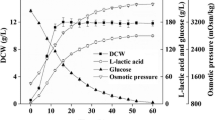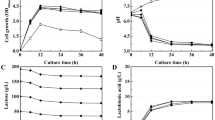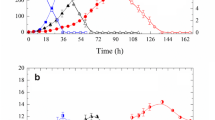Abstract
This paper hinged on the combination effect of two different neutralizing agents Ca(OH)2 and NH4OH on the production of l-lactic acid by Lactobacillus paracasei. Present study quantitatively indicated that environmental osmotic pressure (844–1,772 mOsm/kg) exerted minor influence on l-lactic acid production, but a critical level fell on approximately 3,000 mOsm/kg which restricted l-lactic acid production significantly. Once osmotic pressure exceeded 3,600 mOsm/kg, l-lactic acid production ran aground. A new and efficient neutralizing agent-adding strategy was established in this study to procure 2.21-fold enhancement (5.94 g/l/h) relative to previous productivity of l-lactic acid with NH4OH as neutralizing agent via batch cultivation. It was, therefore, speculated that inhibition effect in the late phase of the fermentation might be in large part attributed to the dramatic increase of environmental osmotic stress, other than cumulative effect of lactate concentration itself.



Similar content being viewed by others
References
Datta R, Henry M (2006) Lactic acid: recent advances in products, processes and technologies—a review. J Chem Technol Biotechnol 81:1119–1129
John RP, Nampoothiri KM, Pandey A (2007) Fermentative production of lactic acid from biomass: an overview on process developments and future perspectives. Appl Microbiol Biotechnol 74:524–534
Okano K, Tanaka T, Ogino C, Fukuda H, Kondo A (2010) Biotechnological production of enantiomeric pure lactic acid from renewable resources: recent achievements, perspectives, and limits. Appl Microbiol Biotechnol 85:413–423
Wee Y, Kim J, Ryu H (2006) Biotechnological production of lactic acid and its recent applications. Food Technol Biotechnol 44:163–172
Zhou Y, Du J, Tsao GT (2002) Comparison of fumaric acid production by Rhizopus oryzae using different neutralizing agents. Bioprocess Biosyst Eng 25:179–181
Nakano S, Ugwu CU, Tokiwa Y (2012) Efficient production of d-(-)-lactic acid from broken rice by Lactobacillus delbrueckii using Ca(OH)2 as a neutralizing agent. Bioresour Technol 104:791–794
Corma A, Iborra S, Velty A (2007) Chemical routes for the transformation of biomass into chemicals. Chem Rev 107:2411–2502
Vaidya AN, Pandey RA, Mudliar S, Kumar MS, Chakrabarti T, Devotta S (2005) Production and recovery of lactic acid for polylactide—an overview. Crit Rev Environ Sci Technol 35:429–467
Bai DM, Yan ZH, Wei Q, Zhao XM, Li XG, Xu SM (2004) Ammonium lactate production by Lactobacillus lactis BME5-18M in pH-controlled fed-batch fermentations. Biochem Eng J 19:47–51
Ding S, Tan T (2006) l-Lactic acid production by Lactobacillus casei fermentation using different fed-batch feeding strategies. Process Biochem 41:1451–1454
Michelson T, Kask K, JÕgi E, Talpsep E, Suitso I, Nurk A (2006) l(+)-Lactic acid producer Bacillus coagulans SIM-7 DSM 14043 and its comparison with Lactobacillus delbrueckii ssp. lactis DSM 20073. Enzyme Microb Technol 39:861–867
Zhu Y, Eiteman MA, DeWitt K, Altman E (2007) Homolactate fermentation by metabolically engineered Escherichia coli strains. Appl Environ Microbiol 73:456–464
Liu LM, Xu QL, Li Y, Shi ZP, Zhu Y, Du GC, Chen J (2007) Enhancement of pyruvate production by osmotic-tolerant mutant of Torulopsis glabrata. Biotechnol Bioeng 4:825–832
Hohmann S (2002) Osmotic stress signaling and osmoadaptation in yeasts. Microbiol Mol Biol Rev 66:300–372
Tsakalidou E, Papadimitriou K (2011) In: Le Marrec C (ed) Responses of lactic acid bacteria to osmotic stress. Springer, New York
Van de Guchte M, Serror P, Chervaux C, Smokvina T, Ehrlich SD, Maguin E (2002) Stress responses in lactic acid bacteria. Antonie Van Leeuwenhoek 82:187–216
Anderson C, Helmerius J, Hodge D, Berglund KA, Rova U (2009) Inhibition of succinic acid production in metabolically engineered Escherichia coli by neutralizing agent, organic acids, and osmolarity. Biotechnol Prog 25:116–123
Fang XJ, Li J, Zheng XY, Xi YL, Chen KQ, Wei P, Ouyang PK, Jiang M (2011) Influence of osmotic stress on fermentative production of succinic acid by Actinobacillus succinogenes. Appl Biochem Biotechnol 165:138–147
Xu S, Zhou JW, Liu LM, Chen J (2010) Proline enhances Torulopsis glabrata growth during hyperosmotic stress. Biotechnol Bioprocess Eng 15:285–292
Ge XY, Yuan J, Qin H, Zhang WG (2011) Improvement of l-lactic acid production by osmotic tolerant mutant of Lactobacillus casei at high temperature. Appl Microbiol Biotechnol 89:73–78
Cao XJ, Lee HJ, Yun HS, Koo YM (2001) Solubilities of calcium and zinc lactates in water and water-ethanol mixture. Korean J Chem Eng 18:133–135
Giraud E, Lelong B, Raimbault M (1991) Influence of pH and initial lactate concentration on the growth of Lactobacillus plantarum. Appl Microbiol Biotechnol 36:96–99
Axe DD, Bailey JE (1995) Transport of lactate and acetate through the energized cytoplasmic membrane of Escherichia coli. Biotechnol Bioeng 47:8–19
Tsakalidou E, Papadimitriou K (2011) Stress responses of lactic acid bacteria. In: Le Marrec C (ed) Responses of lactic acid bacteria to osmotic stress. Springer, New York
Lee PC, Lee WG, Lee SY, Chang HN (1999) Effects of medium components on the growth of Anaerobiospirillum succiniciproducens and succinic acid production. Process Biochem 35:49–55
Liu HJ, Liu DH, Zhong JJ (2006) Quantitative response of trehalose and glycerol syntheses by Candida krusei to osmotic stress of the medium. Process Biochem 41:473–476
Hoffmann T, von Blohn C, Stanek A, Moses S, Barzantny H, Bremer E (2012) Synthesis, release, and recapture of compatible solute proline by osmotically stressed Bacillus subtilis cells. Appl Environ Microbiol 16:753–5762
Purvis JE, Yomano LP, Ingram LO (2005) Enhanced trehalose production improves growth of Escherichia coli under osmotic stress. Appl Environ Microbiol 7:3761–3769
Bai DM, Wei Q, Yan ZH, Zhao XM, Li XG, Xu SM (2003) Fed-batch fermentation of Lactobacillus lactis for hyper-production of l-lactic acid. Biotechnol Lett 25:1833–1835
Liu TJ, Miura S, Arimura T, Tei MY, Park EY, Okabe M (2005) Evaluation of l-lactic acid production in batch, fed-batch, and continuous cultures of Rhizopus sp MK-96-1196 using an airlift bioreactor. Biotechnol Bioprocess Eng 10:522–527
Velazquez AC, Pometto AL, Ho KLG, Demirci A (2001) Evaluation of plastic-composite supports in repeated fed-batch biofilm lactic acid fermentation by Lactobacillus casei. Appl Microbiol Biotechnol 55:434–441
Bruno Z, Srdan G, Vuorilehto K, Durda VR, Ralf T (2004) Process strategies to enhance pyruvate production with recombinant Escherichia coli: from repetitive fed-batch to in situ product recovery with fully integrated electrodialysis. Biotechnol Bioeng 85:638–646
Kazutoyo Y, Tetsushi T, Yongsoo P, Mitsuyasu O (1995) Breeding of Aspergillus terreus mutant TN-484 for itaconic acid production with high yield. J Ferment Bioeng 79:506–508
Acknowledgments
The authors gratefully acknowledge the financial support of the National Key Basic Research Program of China (973 Program, 2013CB733600) and the National Major Scientific and Technological Special Project for “Significant Scientific Instrument and Equipment Development” (2012YQ150087). The National Science and Technology Support Program (2012BAI44G01), National High Technology Research and Development Program 863 (2012AA021201) are also acknowledged.
Author information
Authors and Affiliations
Corresponding authors
Rights and permissions
About this article
Cite this article
Tian, X., Wang, Y., Chu, J. et al. l-Lactic acid production benefits from reduction of environmental osmotic stress through neutralizing agent combination. Bioprocess Biosyst Eng 37, 1917–1923 (2014). https://doi.org/10.1007/s00449-014-1166-9
Received:
Accepted:
Published:
Issue Date:
DOI: https://doi.org/10.1007/s00449-014-1166-9




